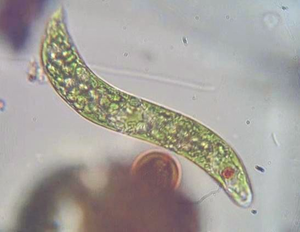Difference between revisions of "Protist"
(Created page with "==Key Stage 4== ===Meaning=== A '''protist''' is a eukaryotic unicellular organism with a cell membrane, cell wall,...") |
|||
| (4 intermediate revisions by 2 users not shown) | |||
| Line 1: | Line 1: | ||
==Key Stage 4== | ==Key Stage 4== | ||
===Meaning=== | ===Meaning=== | ||
| − | A '''protist''' is a [[Eukaryotic Cell|eukaryotic | + | A '''protist''' is a [[unicellular]] [[Eukaryotic Cell|eukaryotic]] [[organism]] with a [[Cell Membrane|cell membrane]], [[Cell Wall|cell wall]], [[cytoplasm]], [[mitochondria]], and a [[Nucleus (Biology)|nucleus]] and may also contain [[chloroplast]]s. |
| + | |||
| + | ===About Protists=== | ||
| + | : '''Protists''' are sometimes called '''protoctists'''. | ||
| + | : Two '''protists''' you may know are; [[amoeba]] and [[euglena]]. | ||
| + | |||
| + | ===Examples=== | ||
| + | {| class="wikitable" | ||
| + | |- | ||
| + | |[[File:Euglena.png|center|300px]] | ||
| + | |[[File:Amoeba.png|center|300px]] | ||
| + | |- | ||
| + | | style="height:20px; width:300px; text-align:center;" |A [[euglena]] is a type of '''protist''' with [[chloroplast]]s and a [[flagellum]]. | ||
| + | | style="height:20px; width:300px; text-align:center;" |An [[amoeba]] is a type of '''protist''' which moves using [[pseudopodia]] and has no [[chloroplast]]s. | ||
| + | |} | ||
| + | |||
| + | |||
| + | ===References=== | ||
| + | ====AQA==== | ||
| + | |||
| + | :[https://www.amazon.co.uk/gp/product/0008158754/ref=as_li_tl?ie=UTF8&camp=1634&creative=6738&creativeASIN=0008158754&linkCode=as2&tag=nrjc-21&linkId=27ad53b0283feeff7fc5ae04a9e205f460 ''Protist, pages 138, 146, GCSE Biology; Student Book, Collins, AQA ''] | ||
| + | :[https://www.amazon.co.uk/gp/product/1782946381/ref=as_li_tl?ie=UTF8&camp=1634&creative=6738&creativeASIN=1782946381&linkCode=as2&tag=nrjc-21&linkId=5ec5fc3f6429e30c1d9ab9bca2bccf93 ''Protists, pages 124, 127, GCSE Combined Science Trilogy; Biology, CGP, AQA ''] | ||
| + | :[https://www.amazon.co.uk/gp/product/1782945954/ref=as_li_tl?ie=UTF8&camp=1634&creative=6738&creativeASIN=1782945954&linkCode=as2&tag=nrjc-21&linkId=100574c08fbbb64318256eb79ed61a76 ''Protists, pages 130, 133, GCSE Biology, CGP, AQA ''] | ||
| + | :[https://www.amazon.co.uk/gp/product/1782945598/ref=as_li_tl?ie=UTF8&camp=1634&creative=6738&creativeASIN=1782945598&linkCode=as2&tag=nrjc-21&linkId=ad276ad49df77ab4b40ab4fd0fe10205 ''Protists, pages 42, 45, GCSE Combined Science; The Revision Guide, CGP, AQA ''] | ||
| + | :[https://www.amazon.co.uk/gp/product/1782945563/ref=as_li_tl?ie=UTF8&camp=1634&creative=6738&creativeASIN=1782945563&linkCode=as2&tag=nrjc-21&linkId=9a1d023a374038e6072f33c4f3cf808b ''Protists, pages 46, 47, GCSE Biology; The Revision Guide, CGP, AQA ''] | ||
| + | :[https://www.amazon.co.uk/gp/product/0198359373/ref=as_li_tl?ie=UTF8&camp=1634&creative=6738&creativeASIN=0198359373&linkCode=as2&tag=nrjc-21&linkId=952a73bbb09d222ecc4b50d200679849 ''Protists, pages 88-89, GCSE Biology; Third Edition, Oxford University Press, AQA ''] | ||
| + | |||
| + | ====Edexcel==== | ||
| + | |||
| + | :[https://www.amazon.co.uk/gp/product/1292120207/ref=as_li_tl?ie=UTF8&camp=1634&creative=6738&creativeASIN=1292120207&linkCode=as2&tag=nrjc-21&linkId=22455ff53961978667722edaa64c0be5 ''Protist, pages 102, 124, GCSE Biology, Pearson, Edexcel ''] | ||
| + | :[https://www.amazon.co.uk/gp/product/1782948120/ref=as_li_tl?ie=UTF8&camp=1634&creative=6738&creativeASIN=1782948120&linkCode=as2&tag=nrjc-21&linkId=dedef775c6a43dbb0a609441525adac0 ''Protists, pages 153, 156, GCSE Biology, CGP, Edexcel ''] | ||
| + | :[https://www.amazon.co.uk/gp/product/1782945741/ref=as_li_tl?ie=UTF8&camp=1634&creative=6738&creativeASIN=1782945741&linkCode=as2&tag=nrjc-21&linkId=30da4f2178da182547b62a7329d13b57 ''Protists, pages 35, 39, GCSE Combined Science; The Revision Guide, CGP, Edexcel ''] | ||
| + | :[https://www.amazon.co.uk/gp/product/1782946748/ref=as_li_tl?ie=UTF8&camp=1634&creative=6738&creativeASIN=1782946748&linkCode=as2&tag=nrjc-21&linkId=a4f0348fc37d0ba1bb52d27f8679581f ''Protists, pages 49, 55, GCSE Biology; The Revision Guide, CGP, Edexcel ''] | ||
| + | |||
| + | ====OCR==== | ||
| + | :[https://www.amazon.co.uk/gp/product/1782945660/ref=as_li_tl?ie=UTF8&camp=1634&creative=6738&creativeASIN=1782945660&linkCode=as2&tag=nrjc-21&linkId=83aa4500ad7759e7f401a1c5ba5df758 ''Protists, page 92, Gateway GCSE Biology; The Revision Guide, CGP, OCR ''] | ||
| + | :[https://www.amazon.co.uk/gp/product/1782945695/ref=as_li_tl?ie=UTF8&camp=1634&creative=6738&creativeASIN=1782945695&linkCode=as2&tag=nrjc-21&linkId=ceafcc80bcad6b6754ee97a0c7ceea53 ''Protists, pages 67, 68, Gateway GCSE Combined Science; The Revision Guide, CGP, OCR ''] | ||
Latest revision as of 17:06, 18 December 2019
Contents
Key Stage 4
Meaning
A protist is a unicellular eukaryotic organism with a cell membrane, cell wall, cytoplasm, mitochondria, and a nucleus and may also contain chloroplasts.
About Protists
Examples
| A euglena is a type of protist with chloroplasts and a flagellum. | An amoeba is a type of protist which moves using pseudopodia and has no chloroplasts. |
References
AQA
- Protist, pages 138, 146, GCSE Biology; Student Book, Collins, AQA
- Protists, pages 124, 127, GCSE Combined Science Trilogy; Biology, CGP, AQA
- Protists, pages 130, 133, GCSE Biology, CGP, AQA
- Protists, pages 42, 45, GCSE Combined Science; The Revision Guide, CGP, AQA
- Protists, pages 46, 47, GCSE Biology; The Revision Guide, CGP, AQA
- Protists, pages 88-89, GCSE Biology; Third Edition, Oxford University Press, AQA
Edexcel
- Protist, pages 102, 124, GCSE Biology, Pearson, Edexcel
- Protists, pages 153, 156, GCSE Biology, CGP, Edexcel
- Protists, pages 35, 39, GCSE Combined Science; The Revision Guide, CGP, Edexcel
- Protists, pages 49, 55, GCSE Biology; The Revision Guide, CGP, Edexcel

